Abstract
Changes in public opinion and legislation have led to the general recognition that solid waste treatment practices must be changed. Solid-waste disposal by landfill is becoming increasingly expensive and regulated and no longer represents a long-term option in view of limited land space and environmental problems. Yard waste, a significant component of municipal solid waste, has previously not been separated from the municipal solid-waste stream. The treatment of municipal solid waste including yard waste must urgently be addressed because disposal via landfill will be prohibited by legislation. Separation of yard waste from municipal solid waste will be mandated in many localities, thus stressing the importance of scrutinizing current composting practices in treating grass clippings, leaves, and other yard residues. Yard waste poses a potential environmental health problem as a result of the widespread use of pesticides in lawn and tree care and the persistence of the residues of these chemicals in plant tissue. Yard waste containing pesticides may present a problem due to the recalcitrant and toxic nature of the pesticide molecules. Current composting processes are based on various modifications of either window systems or in-vessel systems. Both types of processes are ultimately dependent on microbial bioconversions of organic material to innocuous end products. The critical stage of the composting process is the thermophilic phase. The fate and mechanism of removal of pesticides in composting processes is largely unknown and in need of comprehensive analysis.
Full text
PDF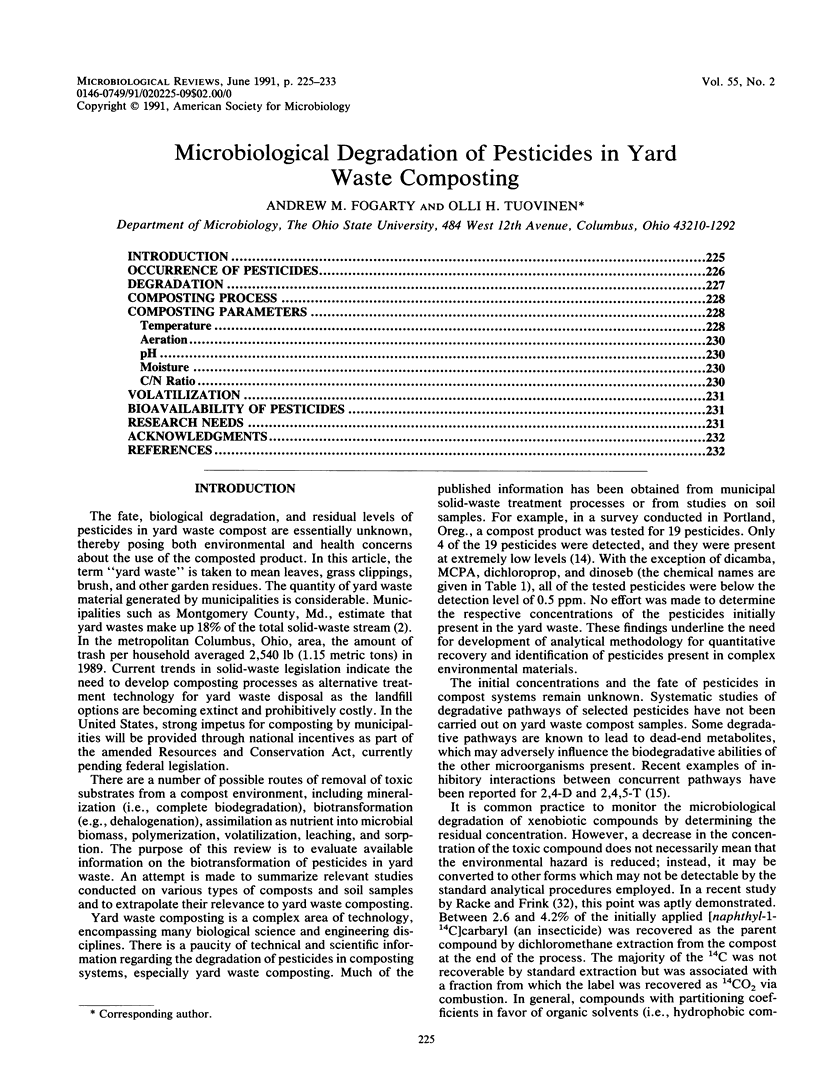
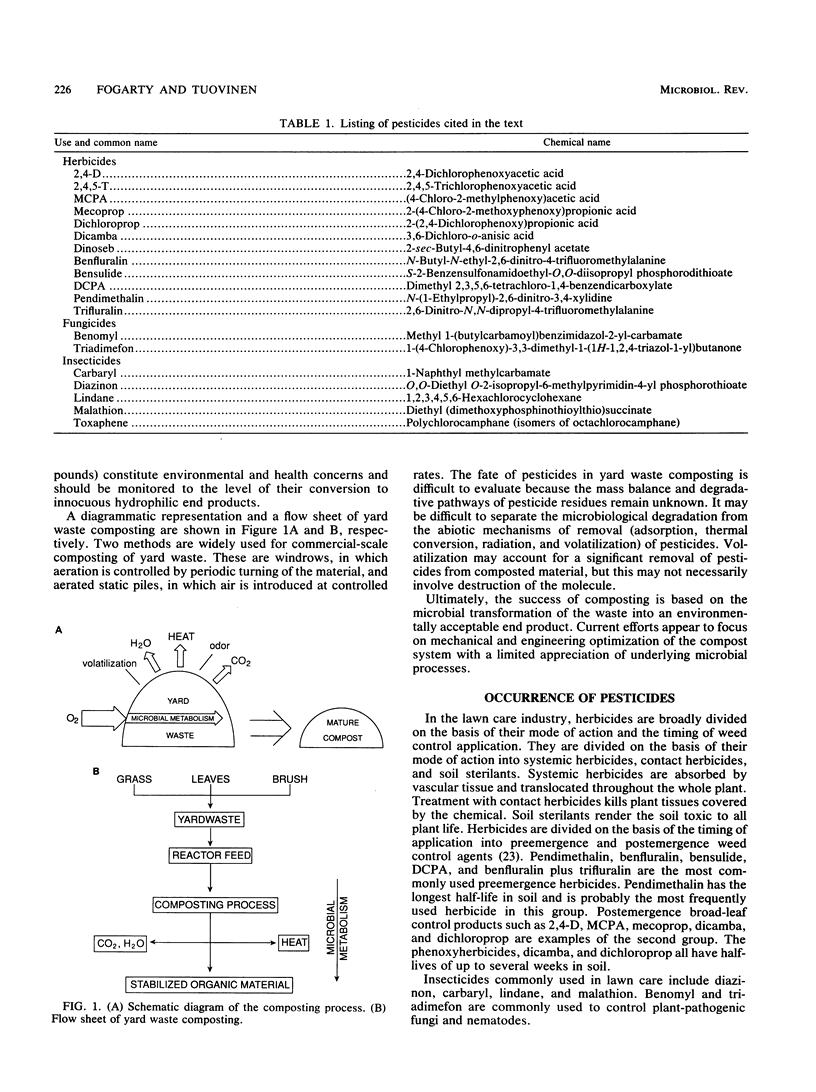
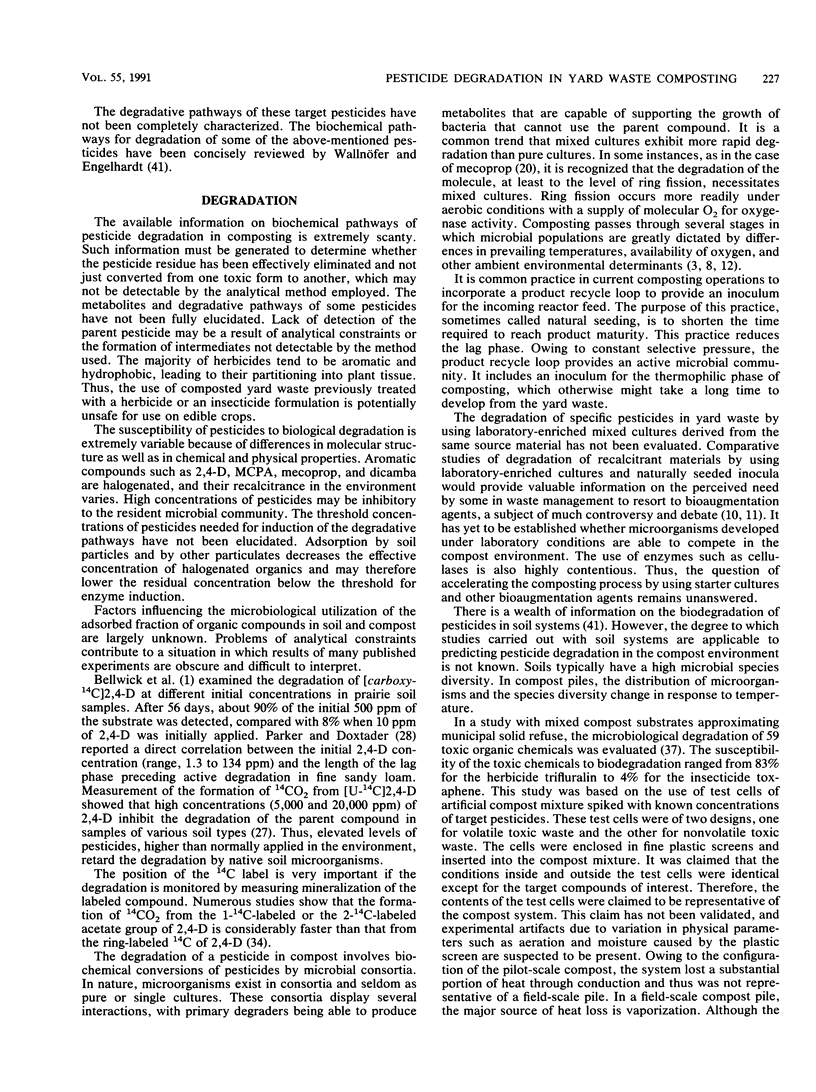
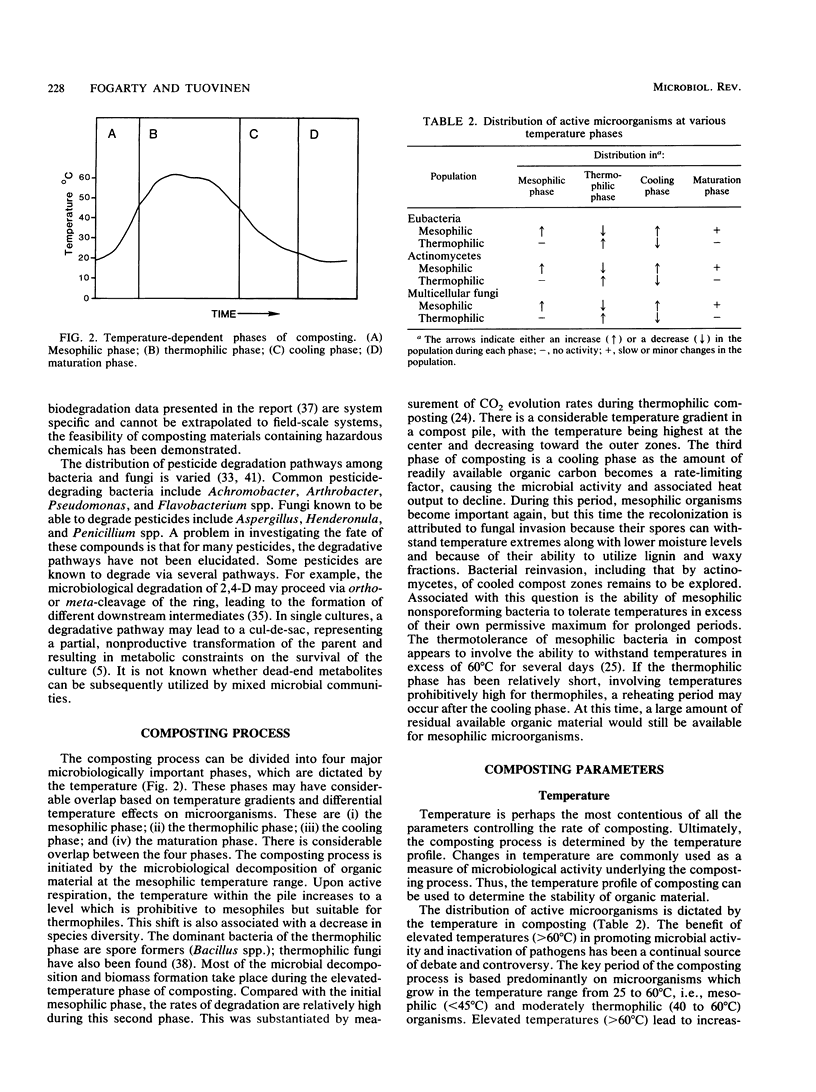



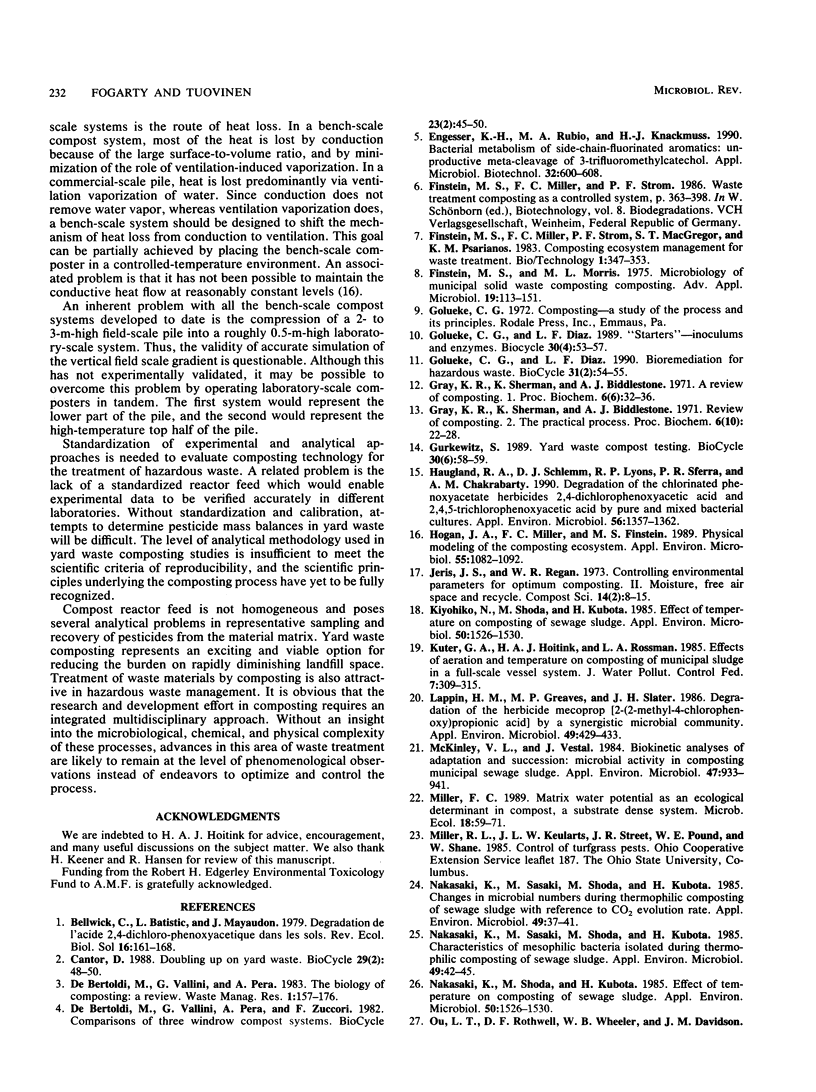
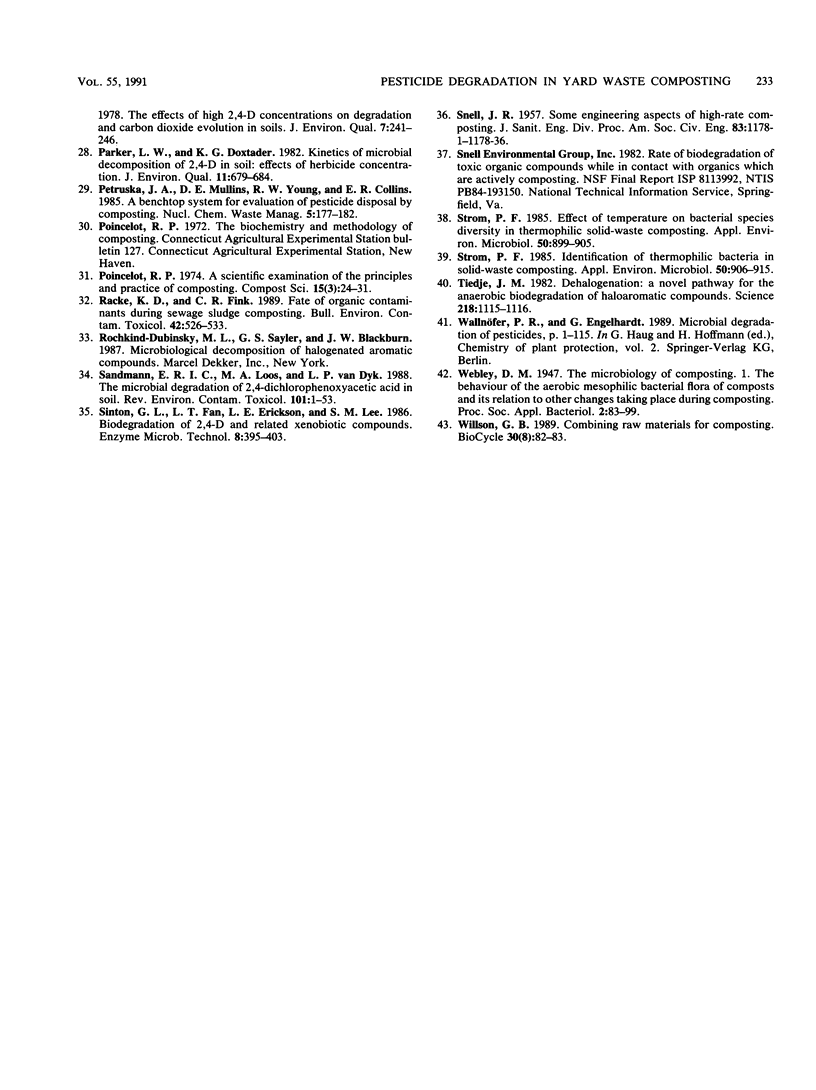
Selected References
These references are in PubMed. This may not be the complete list of references from this article.
- Engesser K. H., Rubio M. A., Knackmuss H. J. Bacterial metabolism of side-chain-fluorinated aromatics: unproductive meta-cleavage of 3-trifluoromethylcatechol. Appl Microbiol Biotechnol. 1990 Feb;32(5):600–608. doi: 10.1007/BF00173734. [DOI] [PubMed] [Google Scholar]
- Finstein M. S., Morris M. L. Microbiology of municipal solid waste composting. Adv Appl Microbiol. 1975;19:113–151. doi: 10.1016/s0065-2164(08)70427-1. [DOI] [PubMed] [Google Scholar]
- Haugland R. A., Schlemm D. J., Lyons R. P., 3rd, Sferra P. R., Chakrabarty A. M. Degradation of the chlorinated phenoxyacetate herbicides 2,4-dichlorophenoxyacetic acid and 2,4,5-trichlorophenoxyacetic acid by pure and mixed bacterial cultures. Appl Environ Microbiol. 1990 May;56(5):1357–1362. doi: 10.1128/aem.56.5.1357-1362.1990. [DOI] [PMC free article] [PubMed] [Google Scholar]
- Hogan J. A., Miller F. C., Finstein M. S. Physical modeling of the composting ecosystem. Appl Environ Microbiol. 1989 May;55(5):1082–1092. doi: 10.1128/aem.55.5.1082-1092.1989. [DOI] [PMC free article] [PubMed] [Google Scholar]
- Lappin H. M., Greaves M. P., Slater J. H. Degradation of the herbicide mecoprop [2-(2-methyl-4-chlorophenoxy)propionic Acid] by a synergistic microbial community. Appl Environ Microbiol. 1985 Feb;49(2):429–433. doi: 10.1128/aem.49.2.429-433.1985. [DOI] [PMC free article] [PubMed] [Google Scholar]
- McKinley V. L., Vestal J. R. Biokinetic analyses of adaptation and succession: microbial activity in composting municipal sewage sludge. Appl Environ Microbiol. 1984 May;47(5):933–941. doi: 10.1128/aem.47.5.933-941.1984. [DOI] [PMC free article] [PubMed] [Google Scholar]
- Nakasaki K., Sasaki M., Shoda M., Kubota H. Change in Microbial Numbers during Thermophilic Composting of Sewage Sludge with Reference to CO(2) Evolution Rate. Appl Environ Microbiol. 1985 Jan;49(1):37–41. doi: 10.1128/aem.49.1.37-41.1985. [DOI] [PMC free article] [PubMed] [Google Scholar]
- Nakasaki K., Sasaki M., Shoda M., Kubota H. Characteristics of Mesophilic Bacteria Isolated during Thermophilic Composting of Sewage Sludge. Appl Environ Microbiol. 1985 Jan;49(1):42–45. doi: 10.1128/aem.49.1.42-45.1985. [DOI] [PMC free article] [PubMed] [Google Scholar]
- Nakasaki K., Shoda M., Kubota H. Effect of temperature on composting of sewage sludge. Appl Environ Microbiol. 1985 Dec;50(6):1526–1530. doi: 10.1128/aem.50.6.1526-1530.1985. [DOI] [PMC free article] [PubMed] [Google Scholar]
- Nakasaki K., Shoda M., Kubota H. Effect of temperature on composting of sewage sludge. Appl Environ Microbiol. 1985 Dec;50(6):1526–1530. doi: 10.1128/aem.50.6.1526-1530.1985. [DOI] [PMC free article] [PubMed] [Google Scholar]
- Racke K. D., Frink C. R. Fate of organic contaminants during sewage sludge composting. Bull Environ Contam Toxicol. 1989 Apr;42(4):526–533. doi: 10.1007/BF01700232. [DOI] [PubMed] [Google Scholar]
- Sandmann E. R., Loos M. A., van Dyk L. P. The microbial degradation of 2,4-dichlorophenoxyacetic acid in soil. Rev Environ Contam Toxicol. 1988;101:1–53. doi: 10.1007/978-1-4612-3770-9_1. [DOI] [PubMed] [Google Scholar]
- Strom P. F. Effect of temperature on bacterial species diversity in thermophilic solid-waste composting. Appl Environ Microbiol. 1985 Oct;50(4):899–905. doi: 10.1128/aem.50.4.899-905.1985. [DOI] [PMC free article] [PubMed] [Google Scholar]
- Strom P. F. Identification of thermophilic bacteria in solid-waste composting. Appl Environ Microbiol. 1985 Oct;50(4):906–913. doi: 10.1128/aem.50.4.906-913.1985. [DOI] [PMC free article] [PubMed] [Google Scholar]
- Suflita J. M., Horowitz A., Shelton D. R., Tiedje J. M. Dehalogenation: a novel pathway for the anaerobic biodegradation of haloaromatic compounds. Science. 1982 Dec 10;218(4577):1115–1117. doi: 10.1126/science.218.4577.1115. [DOI] [PubMed] [Google Scholar]


